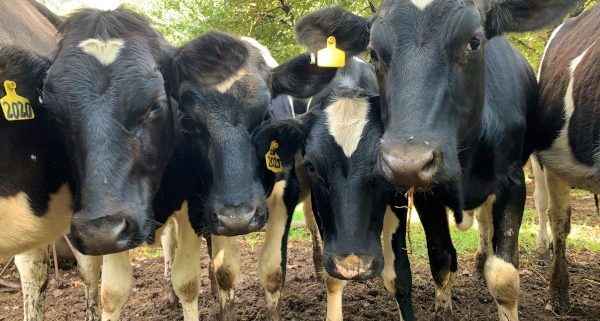Keep these records and make more money – African Farming
No farmer likes paperwork, but as respected independent dairy consultant Johan Heunis and Milk SA transformation director Godfrey Rathogwa recently told a training workshop of about 20 smallholder dairy farmers from across South Africa, avoid record-keeping and you won’t make money!
Records allow a diary farmer, and any other farmer, to compare results over time from different parts of the farming business. These help you understand what is going poorly and needs to be changed, and wat is doing well and should be built on.
Here are some of the top tips Johan and Godfrey shared when it comes to the records dairy farmers should keep if they want to make more profit. “The annual average number of dry cows should always be 20% or less than the number of total cows – cows in milk plus dry cows, but excluding the number of pregnant heifers,” says Johan.
More than 20% means you have fertility and conception problems in your herd. This will reduce the amount of milk you produce, thereby reducing your income. If fertility is poor, the average days in milk will be fewer, which will result in a lower average production over the entire lactation.”
To prevent your milking cow’s average production from dropping, make sure she stays fertile. Monitor all cows for 10 days after they have calved. Look for signs of uterine infection and, should you find any, treat it immediately.
After calving, the dairy manager must record a cow’s first heat. If by 60 days after a cow has calved she is not showing heat, a veterinarian should have a look to see why. If a cow easily comes back into heat, mate her at the first heat 50 days after calving to get her in calf as soon as possible.
“A cow with a low body-condition score at calving can experience all sorts of problems: a retained placenta, excessive anoestrus or poor fertility, and low butterfat in her milk,” Johan continues. “She can also produce 1 000 litres less milk during her next lactation.”
If smallholder farmers want to make enough money to expand their businesses, their cows that are in milk must produce an average of at least 20 litres milk per day throughout their lactation. Of course, the average cow’s monthly production will differ from month to month as seasons and quality of feed change.
IT’S A BUSINESS, SO RUN IT LIKE ONE
“We’re in business, explains Johan. “Producing less milk than you can, for whatever reasons, can cost you as a single smallholder dairy farmer hundreds of thousands of rands a month, and millions a year.”
Records of when a dairy heifer or cow was last mated will indicate when she is due to calve. She should be dried off two months before calving, and her grazing supplemented with maize silage, hay and lick until she calves. Besides planted pastures, Johan believes “quality home-produced feed is king”.
It’s cheaper than buying in, and the farmer can control its production, quality, storage and how it’s used. Having to buy in feed can seriously reduce profits. “The quality of silage is determined by the correct fertilising and weed control during the crop’s growth; by harvesting and inoculating it at the right times; and by ensiling it properly using good compaction, good-quality plastic coverings, and enough tyres to keep the silagetightly covered and compacted,” he explains.
Johan adds that a dairy farmer should ideally produce enough grass, hay and silage to adequately feed the entire herd in the current year and then also have sufficient left over to provide at least 50% of the following year’s total fodder requirements. This additional carryover fodder is a contingency in case of unexpected risks like drought, frost and fires that could severely reduce the farmer’s grass, hay and silage production the following year.
MATCHING NUTRITION TO LIFE STAGE
Johan says a dairy cow of an average 500kg live weight, in early lactation, needs 12kg of dry matter (DM) roughage plus 8kg of concentrate feed a day. Mid-lactation she requires 12kg DM roughage plus 6kg concentrate feed a day, and in late lactation she requires 12kg DM roughage plus 4kg concentrate feed a day.
Dry cows must get 7kg of maize silage plus ad lib hay daily; heifers up to six months must get 18% calf pellets and lucerne hay ad lib daily; heifers of six to 12 months must get 2kg of 16% calf pellets, 2kg maize silage and ad lib hay daily; and heifers of 12 to 24 months must get 5kg maize silage plus 0,5kg protein lick and ad lib hay daily. Johan and Godfrey point out that the dry matter content of maize silage is about 33%.
To feed 1kg DM of maize silage, you must feed 3kg wet material. These are substantial volumes throughout an individual dairy female’s productive life. Detailed record-keeping is required to know and plan for each dairy female’s nutritional needs in a year. Accurate calculations are critical to fodder-flow planning and utilisation.
“If you do not have enough stored fodder or even totally run out of it, your milk production will drop significantly,” cautions Johan. “It is vital that you try to get a loan to buy in more, and to cover the costs of planting enough silage maize for the following year.
The profits you make from maintaining maximum milk production should be more than enough to allow you to repay the loan and to cover the costs of planting maize silage the following summer.
For more information, get in touch with Johan Heunis at johanheunis@igen.co.za or Godfrey Rathogwa at godfrey@milksa.co.za, or visit www.milksa.co.za.




Leave a Reply
Want to join the discussion?Feel free to contribute!